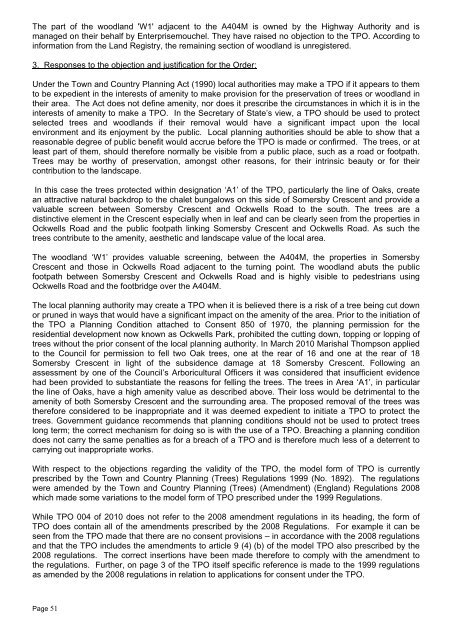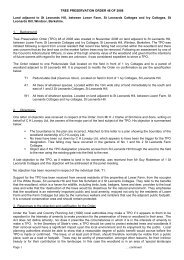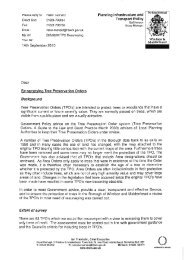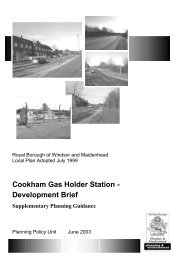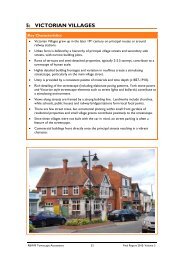Tree Preservation Order 004 of 2010 2 to 28 (evens) Somersby ...
Tree Preservation Order 004 of 2010 2 to 28 (evens) Somersby ...
Tree Preservation Order 004 of 2010 2 to 28 (evens) Somersby ...
Create successful ePaper yourself
Turn your PDF publications into a flip-book with our unique Google optimized e-Paper software.
The part <strong>of</strong> the woodland 'W1' adjacent <strong>to</strong> the A404M is owned by the Highway Authority and is<br />
managed on their behalf by Enterprisemouchel. They have raised no objection <strong>to</strong> the TPO. According <strong>to</strong><br />
information from the Land Registry, the remaining section <strong>of</strong> woodland is unregistered.<br />
3. Responses <strong>to</strong> the objection and justification for the <strong>Order</strong>:<br />
Under the Town and Country Planning Act (1990) local authorities may make a TPO if it appears <strong>to</strong> them<br />
<strong>to</strong> be expedient in the interests <strong>of</strong> amenity <strong>to</strong> make provision for the preservation <strong>of</strong> trees or woodland in<br />
their area. The Act does not define amenity, nor does it prescribe the circumstances in which it is in the<br />
interests <strong>of</strong> amenity <strong>to</strong> make a TPO. In the Secretary <strong>of</strong> State’s view, a TPO should be used <strong>to</strong> protect<br />
selected trees and woodlands if their removal would have a significant impact upon the local<br />
environment and its enjoyment by the public. Local planning authorities should be able <strong>to</strong> show that a<br />
reasonable degree <strong>of</strong> public benefit would accrue before the TPO is made or confirmed. The trees, or at<br />
least part <strong>of</strong> them, should therefore normally be visible from a public place, such as a road or footpath.<br />
<strong>Tree</strong>s may be worthy <strong>of</strong> preservation, amongst other reasons, for their intrinsic beauty or for their<br />
contribution <strong>to</strong> the landscape.<br />
In this case the trees protected within designation ‘A1’ <strong>of</strong> the TPO, particularly the line <strong>of</strong> Oaks, create<br />
an attractive natural backdrop <strong>to</strong> the chalet bungalows on this side <strong>of</strong> <strong>Somersby</strong> Crescent and provide a<br />
valuable screen between <strong>Somersby</strong> Crescent and Ockwells Road <strong>to</strong> the south. The trees are a<br />
distinctive element in the Crescent especially when in leaf and can be clearly seen from the properties in<br />
Ockwells Road and the public footpath linking <strong>Somersby</strong> Crescent and Ockwells Road. As such the<br />
trees contribute <strong>to</strong> the amenity, aesthetic and landscape value <strong>of</strong> the local area.<br />
The woodland ‘W1’ provides valuable screening, between the A404M, the properties in <strong>Somersby</strong><br />
Crescent and those in Ockwells Road adjacent <strong>to</strong> the turning point. The woodland abuts the public<br />
footpath between <strong>Somersby</strong> Crescent and Ockwells Road and is highly visible <strong>to</strong> pedestrians using<br />
Ockwells Road and the footbridge over the A404M.<br />
The local planning authority may create a TPO when it is believed there is a risk <strong>of</strong> a tree being cut down<br />
or pruned in ways that would have a significant impact on the amenity <strong>of</strong> the area. Prior <strong>to</strong> the initiation <strong>of</strong><br />
the TPO a Planning Condition attached <strong>to</strong> Consent 850 <strong>of</strong> 1970, the planning permission for the<br />
residential development now known as Ockwells Park, prohibited the cutting down, <strong>to</strong>pping or lopping <strong>of</strong><br />
trees without the prior consent <strong>of</strong> the local planning authority. In March <strong>2010</strong> Marishal Thompson applied<br />
<strong>to</strong> the Council for permission <strong>to</strong> fell two Oak trees, one at the rear <strong>of</strong> 16 and one at the rear <strong>of</strong> 18<br />
<strong>Somersby</strong> Crescent in light <strong>of</strong> the subsidence damage at 18 <strong>Somersby</strong> Crescent. Following an<br />
assessment by one <strong>of</strong> the Council’s Arboricultural Officers it was considered that insufficient evidence<br />
had been provided <strong>to</strong> substantiate the reasons for felling the trees. The trees in Area ‘A1’, in particular<br />
the line <strong>of</strong> Oaks, have a high amenity value as described above. Their loss would be detrimental <strong>to</strong> the<br />
amenity <strong>of</strong> both <strong>Somersby</strong> Crescent and the surrounding area. The proposed removal <strong>of</strong> the trees was<br />
therefore considered <strong>to</strong> be inappropriate and it was deemed expedient <strong>to</strong> initiate a TPO <strong>to</strong> protect the<br />
trees. Government guidance recommends that planning conditions should not be used <strong>to</strong> protect trees<br />
long term; the correct mechanism for doing so is with the use <strong>of</strong> a TPO. Breaching a planning condition<br />
does not carry the same penalties as for a breach <strong>of</strong> a TPO and is therefore much less <strong>of</strong> a deterrent <strong>to</strong><br />
carrying out inappropriate works.<br />
With respect <strong>to</strong> the objections regarding the validity <strong>of</strong> the TPO, the model form <strong>of</strong> TPO is currently<br />
prescribed by the Town and Country Planning (<strong>Tree</strong>s) Regulations 1999 (No. 1892). The regulations<br />
were amended by the Town and Country Planning (<strong>Tree</strong>s) (Amendment) (England) Regulations 2008<br />
which made some variations <strong>to</strong> the model form <strong>of</strong> TPO prescribed under the 1999 Regulations.<br />
While TPO <strong>004</strong> <strong>of</strong> <strong>2010</strong> does not refer <strong>to</strong> the 2008 amendment regulations in its heading, the form <strong>of</strong><br />
TPO does contain all <strong>of</strong> the amendments prescribed by the 2008 Regulations. For example it can be<br />
seen from the TPO made that there are no consent provisions – in accordance with the 2008 regulations<br />
and that the TPO includes the amendments <strong>to</strong> article 9 (4) (b) <strong>of</strong> the model TPO also prescribed by the<br />
2008 regulations. The correct insertions have been made therefore <strong>to</strong> comply with the amendment <strong>to</strong><br />
the regulations. Further, on page 3 <strong>of</strong> the TPO itself specific reference is made <strong>to</strong> the 1999 regulations<br />
as amended by the 2008 regulations in relation <strong>to</strong> applications for consent under the TPO.<br />
Page 51


